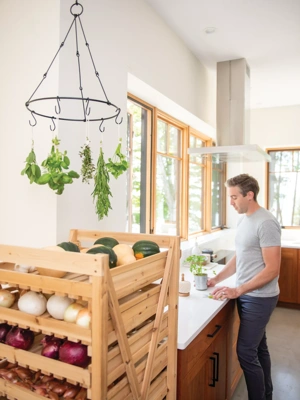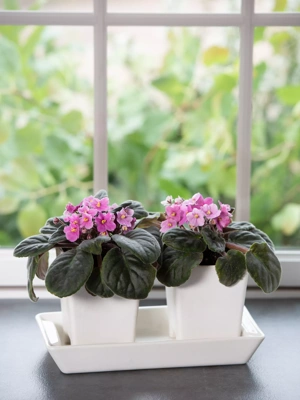Herbs for Health
A sampling of herbs for teas, tinctures, and salves

Whether your garden is in your backyard, or on your balcony, or is a disjointed but happy affair consisting of many prolific windowsills, you have found a way to "Grow Your Own." By growing your own food and flowers you are offsetting your dependence on florists and supermarkets. This power to grow can easily expand beyond the table and the flower vases to the medicine cabinet. With little change to your current set-up you can deliberately add herbs that can play a part in supporting your internal health.
Is yours a pleasure garden, swallowed gleefully in roses and delphiniums, poppies, and peonies? Surely there's room for a few chamomile plants, with pretty white flowers that make a calming tea. Or are you a utilitarian gardener, growing salads and sprouts, cabbages and onions? Perhaps there's room for a small pot of mint to soothe the occasional upset tummy.
Or it is possible you have found a mix of beauty and bounty? Neat rows of parsley growing between tall, decadent stalks of hollyhock? Nasturtium flanking the aisles of alliums? Whatever your style, many herbs are as beautiful as they are healthful.
Healing Herbs, Three Ways
Your ability to grow translates directly into an independence and pride that is not to be undervalued. Here are three ways to use herbs for health.
- Teas: An herbal infusion for your morning cup is an excellent way to benefit from their medicinal properties, especially if you are reducing your caffeine consumption in the process. You can make tea of many garden herbs, some tasting better or more familiar than others. Favorites include all of the mints, tulsi, chamomile. You can mix and match these herbs too. Mint, tulsi, and lemon balm together make a remarkably nuanced cup of tea. If too bitter, a small spoonful of raw honey goes a long way.
- Tinctures: Herbal tinctures allow you to get a concentrated amount of the medicinal power of the herb in a relatively small, efficient dose. Favorite tinctures include echinacea and elderberry.
- Salves: Herbs don't need to be ingested to do their work. Many herbs can heal topically as well; all you need is a carrier, like beeswax, to easily apply them. Comfrey and calendula lend themselves well to salves.
Below is a small variety of beginning plants — two perennial and one annual — that will serve as a jumping-off point to inspire your already-green thumb.


Make Echinacea Tea
The tea is used as an immune booster to help your body fight against colds. Note: If you have a ragweed allergy you will want to stay away from echinacea as the two are in the same family. Pollinators love echinacea and the flowers add stunning pinks to the garden.
The entirety of the Echinacea purpurea plant — flowers, leaves, roots — is used to make this tea. All three parts of the plant can be used fresh or dried. As this is an immune booster it is most likely you will be using the tea in the winter, when the plant itself has died back and is perhaps long buried under a pile of snow.

So you'll want to harvest the root, leaves, and the flowers of the plant while it's still growing. Harvest should come after the flowers have bloomed but before they begin to die. Be sure to harvest leaves and flowers that look healthy. Anything covered in insects or brown spots should be avoided. Take care to leave some of the abundance of the root for next year's growth, as this is a perennial. You can easily split the roots with a sharp spade to leave some behind.
Dry the harvest using screens stacked upon each other with enough proper airflow. Be sure to dry in a well-ventilated, dark place. Once fully dried, you can store the different parts of the plant in clean, labeled jars, so you will be ready once cold season strikes.
When you feel a cold coming on, steep together a small sampling of each plant part in hot water for 15-20 minutes. Strain and sweeten as needed. Try the tea 2-3 times a day for 3 days to help your body fight whatever winter cold is coming at it.
Make an Elderberry Tincture
Use this tincture as an immune support when you feel a seasonal sickness approaching. Elderberry bushes (Sambucus nigra) are remarkably prolific and intelligent creatures. Their flowers ripen at different times of the summer in order for their berries to avoid being totally decimated by the local birds. They also grow very fast and very tall. Be sure you plant them in a part of your garden that can allow for such exuberance. The berries themselves are lightly poisonous and can cause nausea if consumed raw, so don't be tempted to nibble. To avoid having to process a bunch of tiny batches, you can harvest once a week when the berries ripen to a dark purple-red. Place the berries into plastic bags and freeze. Repeat this process until you are satisfied with your haul.
De-stem the berries. This process is made infinitely easier with frozen berries (the fresh ones are hard to disentangle). Compost the stems and chaff.
Fill a jar with your cleaned berries — do not pack tightly — and then pour vodka or another high-proof alcohol (at least 100%) over the berries to fill the jar. Let the jar sit in a cool, dark place for 4-6 weeks. Turn the jar a few times each week. Strain into a clean jar and refrigerate. Take 1 tablespoon every day in winter to help support your immune system.
Make Calendula Salve
This salve is great to heal chapped skin and lips. The combination of calendula-infused oil and beeswax makes it easy to apply. Calendula is an annual that includes varieties with flowers in a range of stunning colors. My favorite is Strawberry calendula but any variety will do. You will need only the flowers for the salve.
Harvest the flowers in the morning once the dew has dried. Place them on a screen in a dark spot with good ventilation and allow them to thoroughly dry.

Create an infused oil by placing the dried flowers in a clean jar and filling it with a light (non extra virigin) olive oil. Allow to infuse on a windowsill for several weeks. Then strain the infused oil with cheesecloth.
Pour strained oil into the top pan of a double boiler and gently warm it over medium-low heat. For every 3-4 fluid ounces (about a half cup) of oil, add in .5 ounces beeswax. Stir gently and occasionally until the wax has melted and mixed with the oil. Pour into small jars or tins. Note: Set aside a special pan for making salves, because it is difficult to clean a pan in which you've melted beeswax.
Coming Full Circle
For a July lunch at your house you have the privilege to shop for the salad's makings among your rows, or bringing in a handful of snapdragons for the table, or perhaps a few clippings of chives for the summer soup. And should you or one of your guests have need of a healing herb remedy, you'll be prepared.
Last updated: 05/30/2023
Print this Article:
Related items
Get the Dirt
Stay up to date on new articles and advice. Please fill out the information below.









